The Catholic funeral rites are a structured process rooted in tradition, providing comfort and hope. They include the Vigil Service, Funeral Mass, and Rite of Committal, reflecting the Church’s belief in eternal life through prayer and liturgy.
Overview of Catholic Funeral Rites
Catholic funeral rites are a sacred sequence of ceremonies that honor the deceased while offering comfort to mourners. The process typically includes the Vigil Service, Funeral Mass, and Rite of Committal, each serving distinct spiritual purposes. These rites are guided by the Church’s teachings on eternal life, resurrection, and the mercy of God. The Order of Christian Funerals outlines the structure, ensuring a dignified and meaningful celebration of the deceased’s life.
Significance of Funeral Rites in Catholic Tradition
Catholic funeral rites hold profound significance as they prayerfully accompany the deceased to eternal life and comfort mourners. These rituals, rooted in tradition and faith, express hope in the resurrection and God’s mercy. The rites provide a sacred framework to honor the deceased, offer spiritual support to the grieving, and reaffirm the Church’s belief in eternal life. They are a meaningful way to celebrate the life of the departed while fostering communal prayer and consolation among the faithful.
Structure of Catholic Funeral Rites
The Catholic funeral rites are structured into three main parts: the Vigil Service, the Funeral Mass, and the Rite of Committal. The Vigil Service, often held before the Funeral Mass, involves prayer and reflection. The Funeral Mass is the central ceremony, celebrating the deceased’s life and offering prayers for their soul. The Rite of Committal concludes the rites at the cemetery, emphasizing the final farewell and hope of resurrection. These structured rituals guide the faithful through grief and hope.

The Vigil Service
The Vigil Service, often held before the Funeral Mass, includes prayers, reflections, and eulogies, providing comfort to mourners and preparing for the sacred funeral rites ahead.
Purpose of the Vigil Service
The Vigil Service offers a time for prayer, reflection, and comfort, honoring the deceased while preparing the community for the Funeral Mass. It provides an opportunity for loved ones to gather, share memories, and find solace in faith, emphasizing hope in eternal life and resurrection.
Elements of the Vigil Service
The Vigil Service typically includes prayer, Scripture readings, and a rosary or litany, providing a sacred space for mourning. Family and friends gather to share memories, offering comfort and support. The service may also include a eulogy, focusing on the deceased’s life and faith. These elements collectively prepare the community for the Funeral Mass, fostering reflection and hope in eternal life.
Role of Family and Friends in the Vigil
Family and friends play a vital role in the Vigil Service by participating in prayers, sharing memories, and offering comfort. They may lead or participate in the rosary, readings, or eulogy, fostering a sense of community and support; Their presence honors the deceased and provides solace to mourners, emphasizing the shared journey of grief and hope rooted in faith.

The Funeral Mass
The Funeral Mass is the central ceremony, celebrating the deceased’s life with prayers, readings, and the Eucharist. It reflects the Church’s belief in eternal life, offering comfort through liturgy and communal worship, while honoring the deceased and supporting the grieving.
The Funeral Mass: A Celebration of Life
The Funeral Mass is a sacred liturgical celebration honoring the deceased, emphasizing the hope of eternal life through Christ’s resurrection. It includes readings, prayers, and the Eucharist, offering comfort to mourners. The Mass proclaims God’s mercy and the promise of resurrection, providing solace while celebrating the life of the departed. This central ritual reflects the Church’s belief in the transformative power of faith, uniting the community in prayer and hope.
Role of the Priest in the Funeral Mass
The priest plays a central role in the Funeral Mass, presiding over the liturgy and offering prayers for the deceased. They consecrate the Eucharist, deliver the homily, and provide spiritual guidance to the mourners. The priest also leads the final commendation, commending the soul to God’s mercy. Their presence ensures the sacredness of the ritual, offering comfort and hope to the grieving while upholding the Church’s traditions and teachings on eternal life.
Role of Music in the Funeral Mass
Music plays a vital role in the Funeral Mass, offering consolation and expressing the hope of resurrection. Hymns and chants are selected to reflect the deceased’s life and faith, creating a solemn yet uplifting atmosphere. The liturgical music aligns with Catholic teachings, emphasizing prayer for the deceased and comfort for the mourners. It serves as a powerful medium to convey grief, hope, and the belief in eternal life, enriching the sacred ritual of the Funeral Mass.
Importance of the Eulogy
The eulogy serves as a personal tribute to the deceased, celebrating their life, achievements, and character. It provides an opportunity for family and friends to share memories, offering comfort and inspiration to mourners. While it personalizes the funeral service, the eulogy must align with Catholic teachings and maintain reverence within the liturgical context. It helps to humanize the deceased and brings a sense of closure, while also affirming faith and hope in eternal life.
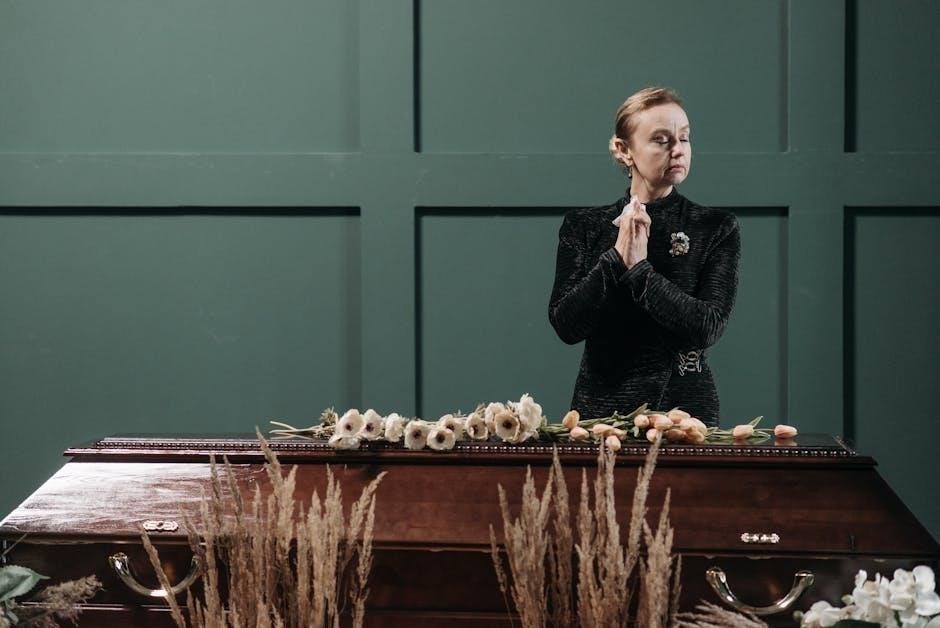
The Rite of Committal
The Rite of Committal marks the final farewell, with prayers and blessings at the cemetery, ensuring dignity and hope as the deceased enters eternal rest.
Purpose of the Rite of Committal
The Rite of Committal serves as the final farewell, committing the deceased to their resting place with dignity. It includes prayers and blessings at the cemetery, offering comfort to mourners. This rite emphasizes faith in eternal life, honoring the deceased while providing solace to those grieving. It marks the conclusion of the funeral rites, entrusted to God’s mercy and the hope of resurrection, reflecting the sacredness of life and the promise of eternal rest.
Prayers and Blessings at the Cemetery
Prayers and blessings at the cemetery are sacred moments in Catholic funeral rites, offering solace to mourners. The priest recites specific prayers, often including the Our Father and committal prayers, to ask for God’s mercy and peace for the deceased. Holy water may be sprinkled on the casket, symbolizing purification and hope. These rituals, outlined in the Order of Christian Funerals, provide comfort and reaffirm the belief in eternal life, helping the grieving to find strength in faith and communal support.
Burial vs. Cremation: Procedures and Preferences
The Catholic Church permits both burial and cremation, though it prefers burial to honor the body as a temple of the Holy Spirit. Cremated remains must be treated with dignity, not scattered or used for keepsakes, and should be buried in a sacred place. The Funeral Mass may occur with the body present, or, if cremated, the urn may be present. The Church emphasizes respect for the deceased, ensuring procedures align with Catholic teachings and the families’ preferences.
Order of Christian Funerals
The Order of Christian Funerals is a structured guide outlining Catholic funeral rites, providing a meaningful framework for celebrating the Paschal Mystery and comforting the bereaved.
Overview of the Order of Christian Funerals
The Order of Christian Funerals is a liturgical document guiding Catholic funeral rites, divided into three main parts: the Vigil, Funeral Mass, and Rite of Committal. It provides a structured framework for celebrating the deceased’s life, comforting mourners, and expressing hope in resurrection. The document reflects the Church’s belief in eternal life and offers prayers, rituals, and liturgy to honor the deceased while supporting the grieving community through faith.
Historical Development of the Order of Christian Funerals
The Order of Christian Funerals has evolved over centuries, rooted in early Christian burial practices and liturgical traditions. Following Vatican II, it was revised to reflect modern liturgical renewal, emphasizing hope in resurrection and comfort for mourners. The document incorporates ancient rituals while adapting to contemporary needs, ensuring a balanced blend of tradition and relevance in guiding Catholic funeral rites.
Role of the Order in Funeral Planning
The Order of Christian Funerals serves as a comprehensive guide for planning Catholic funerals, outlining the three main rites: the Vigil, Funeral Mass, and Rite of Committal. It provides structure and liturgical direction, ensuring the rites reflect Catholic teachings on eternal life and resurrection. Families and priests use this document to select appropriate prayers, readings, and music, balancing tradition with personalization to honor the deceased and comfort mourners.

Cremation in Catholic Funeral Rites
Cremation is permitted but not preferred; the Church emphasizes traditional burial. Guidelines ensure ashes are treated with dignity, stored in a sacred place, respecting the body as a temple of the Holy Spirit.
Catholic Church’s Stance on Cremation
The Catholic Church permits cremation but prefers traditional burial, reflecting respect for the body as a temple of the Holy Spirit. While cremation is allowed, it must align with Christian beliefs in resurrection. Ashes should be treated with dignity, stored in a sacred place, and not scattered. The Church emphasizes that cremation, when chosen, should not diminish the funeral rites’ sacredness or the hope of eternal life through Christ’s resurrection.
Guidelines for Cremation
The Catholic Church allows cremation, provided it is not chosen for reasons contrary to Christian faith. Cremated remains must be treated with dignity, stored in a worthy container, and placed in a sacred location, such as a cemetery. Scattering ashes is not permitted, as it reflects disrespect for the body. The Church recommends that the Funeral Mass occur before cremation, ensuring the rites maintain their sacredness and alignment with the belief in resurrection.
Guidelines for Scattering Ashes
The Catholic Church generally prohibits the scattering of ashes, as it does not align with the dignity owed to the human body. Ashes must be buried or placed in a sacred location, such as a cemetery, to reflect respect for the deceased and the belief in resurrection. Scattering is seen as disrespectful and inconsistent with Catholic teaching, which emphasizes the sacredness of the body as a temple of the Holy Spirit. Some dioceses may permit exceptions under strict guidelines, but this is rare.
Prayers and Liturgy
Catholic funeral liturgy is a celebration of faith, offering prayers for the deceased and comfort to mourners. It includes sacred readings, hymns, and the Eucharist, reflecting hope in resurrection.
Prayers for the Deceased
Catholic funeral rites include specific prayers for the deceased, seeking God’s mercy and forgiveness. These prayers, such as the In Paradisum and the Prayer of Committal, express hope for eternal rest and resurrection. They are rooted in scripture and tradition, offering comfort to mourners while commending the soul to God’s care. The prayers emphasize trust in divine mercy and the belief in eternal life, providing spiritual support during the grieving process.
Liturgy of the Funeral Mass
The Funeral Mass is a sacred celebration honoring the deceased, centered on the Eucharist. It includes the entrance rites, liturgy of the Word, Eucharistic sacrifice, and concluding rites. The Mass proclaims hope in resurrection and intercedes for the deceased, offering comfort to mourners. Prayers and readings reflect trust in God’s mercy, while the Eucharist strengthens the community in faith and unity, emphasizing the belief in eternal life through Christ’s resurrection.
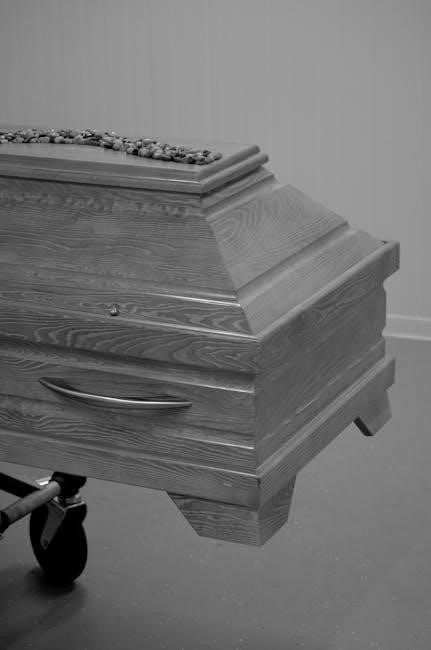
Role of the Priest
The priest leads the funeral liturgy, offering prayers for the deceased, guiding the community in worship, and providing comfort to mourners, ensuring rites reflect Catholic traditions.
Responsibilities of the Priest in Funeral Rites
The priest plays a central role in Catholic funeral rites, leading prayers, presiding over the Funeral Mass, and offering blessings. They provide spiritual guidance, ensuring rituals align with Church teachings, and bring comfort to mourners by invoking God’s mercy and hope of resurrection. The priest’s presence underscores the sacred nature of the rites, helping the community honor the deceased while celebrating eternal life through liturgy and tradition.
Leading the Funeral Liturgy
The priest leads the funeral liturgy, ensuring its proper execution according to Catholic tradition. They preside over the Funeral Mass, delivering the Eucharistic sacrifice and prayers for the deceased. The liturgy reflects Christian hope, emphasizing resurrection and eternal life. The priest guides the assembly through rituals, ensuring the rites honor the deceased while comforting mourners. Their leadership underscores the sacredness of the occasion, aligning the ceremony with Church teachings and liturgical norms.
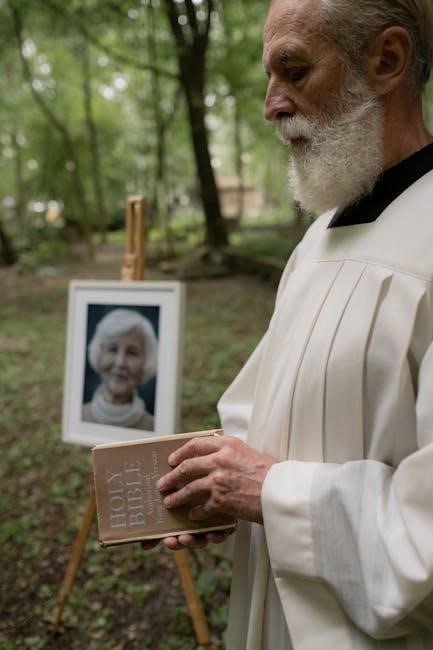
Family Involvement
Families play a vital role in Catholic funeral rites, participating in the Vigil Service and Funeral Mass. They collaborate with the priest and funeral directors to honor their loved one, ensuring the rites reflect their faith and personal connection to the deceased, while finding comfort in the liturgy and communal prayer.
Role of Family in Planning the Funeral
The family plays a central role in planning Catholic funeral rites, collaborating with priests and funeral directors to ensure the ceremonies align with Church traditions. They select readings, hymns, and participate in the liturgy, honoring their loved one’s faith. The Order of Christian Funerals guides their decisions, helping them create a meaningful celebration that reflects the deceased’s life and beliefs, while finding comfort in the prayers and rituals offered for the soul of the departed.
Participation in Funeral Rites
Active participation in Catholic funeral rites is essential, as it unites the community in prayer and provides comfort to the grieving family. Family and friends are encouraged to contribute through readings, hymns, and prayers, emphasizing communal support and faith. This shared involvement reflects the Church’s belief in the power of collective worship to honor the deceased and seek God’s mercy, fostering a sense of hope and unity among all present.
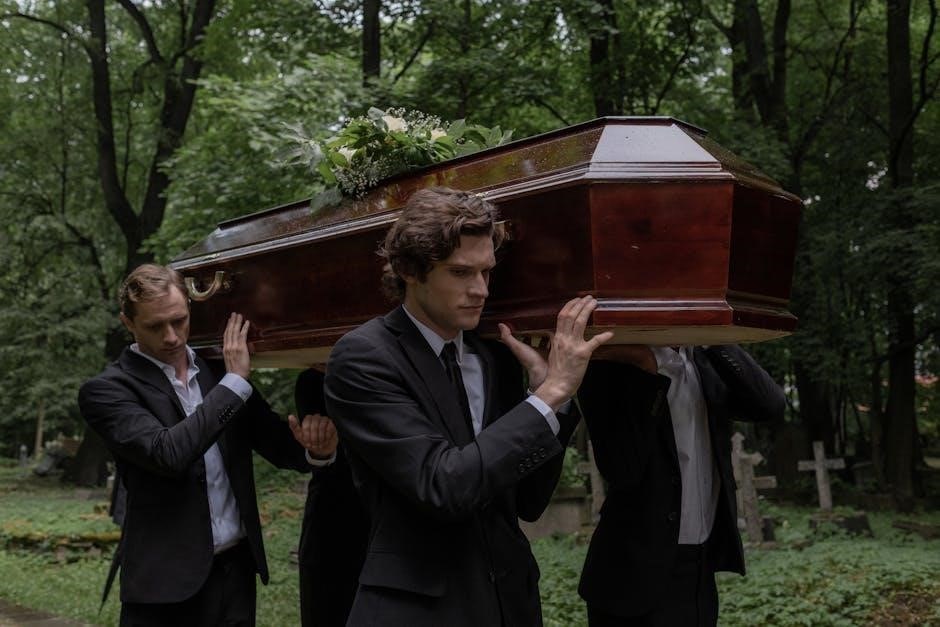
Cultural Variations
Catholic funeral rites incorporate cultural variations, blending regional customs with traditional practices. This respect for diversity provides comfort to grieving families while upholding Church teachings worldwide.
Cultural Adaptations in Catholic Funeral Rites
Catholic funeral rites adapt to cultural traditions, blending local customs with universal Church teachings. For example, in Mexico, the Día de los Muertos honors loved ones, while in the Philippines, families hold elaborate wakes. These practices, rooted in faith, reflect the global diversity of Catholicism. By incorporating regional rituals, the Church respects cultural heritage while maintaining its liturgical integrity. This balance ensures that funeral rites remain meaningful and personal for diverse communities worldwide.
Modern Relevance
Catholic funeral rites remain meaningful in modern secular society, offering comfort and hope through liturgy and tradition. They provide a spiritual framework for grieving, honoring life, and celebrating eternal hope.
Funeral Rites in Modern Secular Society
Catholic funeral rites continue to hold profound meaning in today’s secular world, offering a spiritual framework for processing grief and honoring life. They provide comfort through prayer, liturgy, and communal support, emphasizing hope in eternal life. Even in a secular context, these rites resonate with universal human experiences of loss and the need for transcendence, bridging faith and culture in a way that remains deeply relevant.
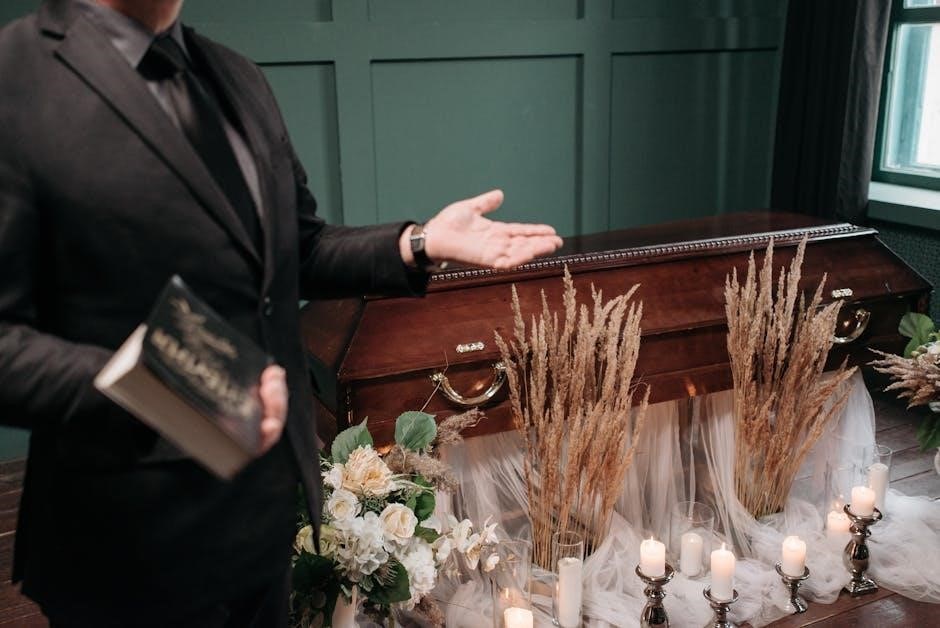
Eternal Life and Resurrection
Catholic funeral rites reflect the belief in eternal life and resurrection, offering hope and comfort. They emphasize Christ’s victory over death, promising eternal rest and reunion with God.
Theme of Eternal Life in Funeral Rites
The theme of eternal life is central to Catholic funeral rites, emphasizing hope and resurrection. These rites reflect the Paschal mystery, celebrating Christ’s victory over death. Through liturgy and prayer, mourners are reminded of the soul’s transition to eternal rest. The focus on eternal life provides comfort, reinforcing the belief in the promise of everlasting peace with God.
Resurrection and Christian Hope
Resurrection and Christian hope are cornerstone themes in Catholic funeral rites, offering solace to mourners. The rituals emphasize Christ’s triumph over death, symbolizing eternal life. Prayers and liturgy highlight the belief in the soul’s resurrection, reinforcing hope for reunification with the deceased. This theological foundation provides comfort, reminding the faithful of God’s promise of eternal peace and the ultimate victory over death through Christ.
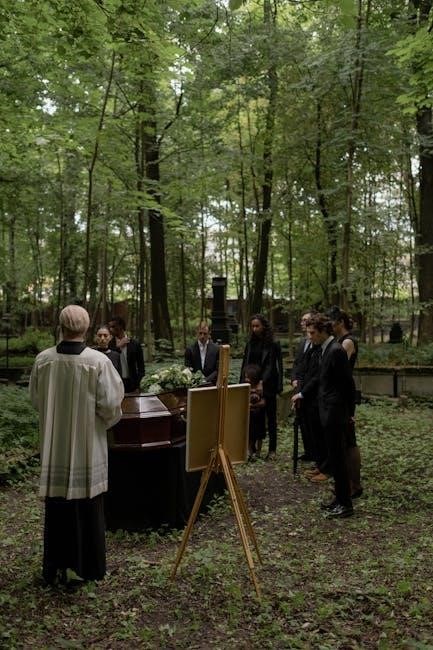
Comforting Mourners
Catholic funeral rites provide comfort through sacred rituals, prayers, and liturgy, offering hope and solace to mourners during their time of grief and loss.
Providing Comfort Through Ritual
Catholic funeral rites offer profound comfort by providing a structured, meaningful way to navigate grief. The Vigil Service, Funeral Mass, and Rite of Committal create a sacred space for mourning, fostering hope and resilience. Prayers, liturgy, and communal support remind the bereaved of God’s mercy and the promise of eternal life, helping them find solace in faith and ritual during their time of loss and sorrow.
Catholic funeral rites provide a meaningful way to honor the deceased, offering comfort, hope, and a reflection of faith in eternal life and resurrection.
Final Thoughts on Catholic Funeral Rites
Catholic funeral rites blend tradition, liturgy, and compassion, offering a profound way to honor the deceased while comforting mourners. These rituals, rooted in faith, provide hope and reassurance of eternal life. The structure, from the Vigil to the Rite of Committal, creates a meaningful journey for those grieving. By celebrating the deceased’s life andcommending their soul to God, Catholic funeral rites reaffirm the community’s faith and provide solace in times of loss.